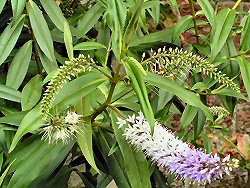The story of how a nuisance shrub was moved, neglected and finally reinstated to become a star of the wildlife garden!
When I first moved into my current house some eight or nine years ago, a huge overgrown hebe was hogging one of the sunniest parts of the garden. The plant was too large for this location and I decided to remove it. The main plant was too big to be saved, but one of the lower branches had naturally 'layered' itself and I saved this plant by moving it into a temporary position in a different part of the garden.
 Hebe still flowering and with plenty more still to come.
Hebe still flowering and with plenty more still to come.
When I created my pond (see
Creating a wildlife-friendly pond) a few years ago, the hebe had to make way yet again; this time into a quite densely shaded part of the 'woodland' garden. I never bothered to care for the plant in any way, but even in this unfavourable spot it doggedly clung on and even produced a few flowers.
This year I finally finished a raised bed in a sunny part of the garden near the house, and looking for a plant to fill a particularly awkward spot close to the boundary fence, I thought of the hebe. I moved the plant to its new location during the summer and almost instantly it started to flourish and even now is producing some wonderful lilac-coloured flowering spikes whose flowers turn white as they age. The plant is like a magnet to hoverflies and from being a rather problematic item, it has now become one of the first plants I look for when entering the garden. I only wish I knew which variety it is - the closest thing I have been able to find is hebe 'Great Orme', but all the pictures of these I have seen have rather redder flowers. If anyone can enlighten me, please get in touch!